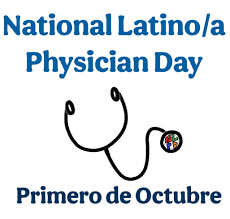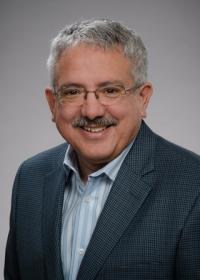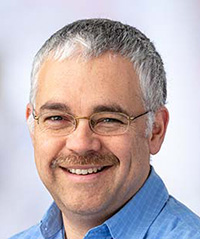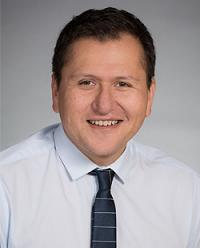
Celebrating National Latino Physician Day
National Latino Physician Day was established on Oct. 1, 2022, as a day to celebrate Hispanic and Latinx physicians in the U.S. and to help build awareness and bridge the gap in representation.
As the National Latino Physician Day mission statement notes, “Healthcare disparities in the Latino community have worsened during the COVID-19 pandemic, adding urgency to the need for Latino physician representation in the U.S. workforce.”
 Leo Morales, MD, PhD, professor (General Internal Medicine) and assistant dean for Healthcare Quality and Equity at UW School of Medicine, adds that data from the State Medical Commission shows that only 3.1% of Washington’s physicians identify as Hispanic or Latino as compared with 14% of the state’s population.
Leo Morales, MD, PhD, professor (General Internal Medicine) and assistant dean for Healthcare Quality and Equity at UW School of Medicine, adds that data from the State Medical Commission shows that only 3.1% of Washington’s physicians identify as Hispanic or Latino as compared with 14% of the state’s population.
“We also know that approximately 29% of Latinos in our state are foreign-born and that 61% speak Spanish at home. Research conducted by the UW Latino Center for Health shows that 75% of Latino physicians report speaking Spanish compared with 13% of non-Latino physicians, speaking to the urgency of training more Latino physicians for the linguistic and cultural competence they bring to the health workforce,” says Morales.
A need for more Hispanic and Latinx physicians
Barriers such as language, as well as implicit bias, can make it difficult for patients who identify as Hispanic or Latinx to get the care they need.
It’s important for Hispanic and Latinx physicians to be represented in our physician populations for better patient outcomes and to encourage a new generation of Hispanic and Latinx physicians.
“Studies show patients prefer to receive care from physicians who belong to their same racial and ethnic group,” says Nathalia Jimenez, MD, MPH, professor and vice chair for Equity, Diversity and Inclusion for the Department of Anesthesiology & Pain Medicine at the UW School of Medicine.
“This is particularly important since racial and ethnic concordance is associated with better treatment adherence, lower emergency department use and fewer hospitalizations overall.”
 Increasing the number of Hispanic and Latinx physicians across the workforce will improve health outcomes for our communities, says Johnnie Orozco, MD, associate professor in the Division of Hematology and Oncology at the UW School of Medicine and a hematologist-oncologist at Fred Hutchinson Cancer Center.
Increasing the number of Hispanic and Latinx physicians across the workforce will improve health outcomes for our communities, says Johnnie Orozco, MD, associate professor in the Division of Hematology and Oncology at the UW School of Medicine and a hematologist-oncologist at Fred Hutchinson Cancer Center.
 Institutions like UW Medicine need to continue to make intentional efforts to avoid a plateau of Latinx providers, says Daniel Cabrera, MD, clinical associate professor in the Division of General Internal Medicine at the UW School of Medicine.
Institutions like UW Medicine need to continue to make intentional efforts to avoid a plateau of Latinx providers, says Daniel Cabrera, MD, clinical associate professor in the Division of General Internal Medicine at the UW School of Medicine.
“The reality is that the field of medicine is falling short in trying to diversify its current and future workforce, specifically as it relates to Latinx physicians. The Latinx community is growing every day in this country and would benefit from physicians coming from those same communities,” says Cabrera.
More representation in learning environments
Hispanic and Latinx students who want to enter the healthcare field also face challenges. A 2019 report by the Latino Policy & Politics Initiative at UCLA found that U.S. medical schools do not admit and graduate enough students from Hispanic backgrounds.
“Students want to go to medical school where they see themselves, where they see the possibility of community, where they see a path forward to their eventual goals, with input and guidance from mentors,” Orozco says.
 Rudy Rodriguez, MD, professor in the Division of Nephrology at the UW School of Medicine, organizes a course on Hispanic health disparities for medical students and covers topics like working with interpreters, mental health, care of undocumented immigrants, occupational health problems among migrant farm workers and more.
Rudy Rodriguez, MD, professor in the Division of Nephrology at the UW School of Medicine, organizes a course on Hispanic health disparities for medical students and covers topics like working with interpreters, mental health, care of undocumented immigrants, occupational health problems among migrant farm workers and more.
“Many of the students in the course are Hispanic, but most are not,” says Rodriguez. “All the students understand the need to become culturally competent to address the health needs of this population.”
Encouraging a new generation of Latinx physicians
Promoting diversity in healthcare doesn’t just start at the medical school level. Jimenez says it needs to begin even sooner and continue through high school and undergraduate education.
“We need to decrease barriers for Latinx children to access high-quality education,” Jimenez says. “This includes making provisions for social safety networks for families regardless of their immigration and language status. It means strengthening STEM programs and exposing Latinx children to role models early in life to allow them to see what is possible for them.”
Ultimately, National Latino Physician Day doesn’t just raise awareness about the underrepresentation of Latinx people in healthcare, says Elina Quiroga, MD, MPH, associate professor in the Department of Surgery at the UW School of Medicine.
“It’s about lighting a path for the next generation of Latinx doctors. When young Latinos see successful role models who look like them and share their background, it becomes more than a career — it becomes a calling they feel inspired to answer,” Quiroga says.